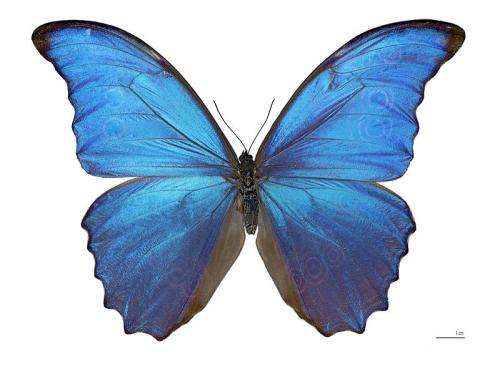October 6, 2014 weblog
Researchers take cells from chrysalis and use them to grow butterfly wings in the lab

A pair of researchers, one from Oxford University, the other with the Natural History Museum in London, has found a way to grow butterfly wings in their lab. In their paper published in Bioinspired, Biomimetic and Nanobiomaterials, Helen Townley and Andrew Parker describe the transparent nature of certain butterfly and beetle wings and their efforts to reproduce them using cell cultures to grow colored materials.
Many butterfly wings, it turns out, are not actually colored by pigments or dyes—instead, their wings are made of transparent three-dimensional structures that only appear to look the color they do because of the way they filter and bend light. Because of the small size and intricate nature of these structures, scientists, despite considerable effort, have been unable to reproduce them—they'd like to be able to do so, however, because it would mean creating coatings that would never fade. In this new effort, the researchers took a more natural route—they took cells from a blue morpho butterfly chrysalis and grew them in a dish in their lab. The effort proved fruitful, as the cells grew into fully formed forewings—the first time it's ever been achieved in a lab.
The pair of researchers were hoping that the cells would continue producing wing structure material as long as they received nutrients, but discovered part of the process resulted in the destruction of the cells. Undeterred, they turned to a type of beetle that creates a shell structure that is in the same form as opal, the gemstone (by producing differing sized nanospherical structures in an array). Those cells kept producing, they found, as long as they were fed, producing a seemingly never ending stream of material.
The two researchers are confident that their studies show that it should, at least theoretically, be possible to create a type of paint, or covering for use on a wide variety of products made from the cells produced from a beetle. They point out that such materials would never fade, noting that similar beetles from millions of years ago that have been unearthed, still have the same colors that had when alive. They also note that they believe what they've discovered is only the beginning—they envision a host of products grown from a wide variety of cells from fish, peacocks, and many types of insects.
More information: Exploring optical manufacturing through cell lines: a first step towards tissue and cell culture of Morpho peleides wing cells, Bioinspired, Biomimetic and Nanobiomaterials 09/2014.
© 2014 Phys.org




















